Thread: Lets ID this cannonball safe.
-
20-12-17, 05:29 PM #21

I don't mind getting a little off topic. The lock/safe forums have been pretty slow so any chatter is good chatter. (pun intended)
The modern tooling is getting more and more versatile. While the tool holder is designed for square tooling it also has a small v in the bottom to support round stock. The boring bar which is made of carbide and has a replaceable carbide bit is extremely rigid. It also has a flat surface on the top to aid in mounting and to keep the cutting angle secure. It is a pricey chunk of metal and I probably wouldn't lay out the cash for it but it came with the lathe/mill combo when I bought it. The previous owner had spent a lot of money on tooling.
There is something to be said for good old HSS tooling. I just was gifted a large selection of HSS tooling from my uncle. When he bought his lathe many moons ago from a 40 year Westinghouse tool and die maker, he got tool boxes full of HHS (small amount of carbide) stock and specially ground bits. At 89, he is passing some on to me. I will cherish them.
I do need to improve my sharpening techniques and equipment though.
Huw, I wish you were a neighbor. I could learn a lot hanging around you. Now, if I could only solve a glitch in the CNC program...
-
20-12-17, 06:15 PM #22

CNC? We don't use the 'C' word in my shed :-O
When you said the digital readout was invaluable I wrongly assumed you had a manual lathe fitted with a 2 or 3-axis DRO, didn't realise you do it auto'd on the c word.
Definitely way to go for repetitive batch work and perhaps as few as say 10 or 12, but for one-off parts or a couple of different washers surely you could turn them manually by hand in a fraction of the time the programming alone would take?
-
20-12-17, 07:53 PM #23

C word, now that's funny.
You assumed correctly, I have been making parts manually. The DRO really shines for that. This machine was DRO and CNC equipped when I bought it. I loaded the program up on a computer and fought a few gremlins but had it operational for the mill. Before I could set up the lathe a health issue sidelined me for a period of time. That's all it took to forget most of what I had learned, so when I needed to make a part I just did it manually. Like you said, it's faster.
CNC does not make a machinist, only a machine operator. That is why the area technical collage still trains the machine tool students on manual machines for a semester. Those days are probably numbered as technology advances. I'm back at fooling around with it but am having some issues. I just might be getting to old as I sometimes deplore tech. That damn Iphone, scanning codes on the kids car, I even got tired of to much tech in the new Corvette. It is now gone and I'm going back to a 60's - 70's muscle car.
In old age I think I will concentrate on Model T's, old safes, and drinking beer. In which order is still to be determined.Last edited by 00247; 20-12-17 at 07:58 PM.
-
20-12-17, 09:36 PM #24

Stunning work, if your beer drinking is of the same quality as your old safes, then respect is due.
-
20-12-17, 11:54 PM #25

+1, I'm still a little way off old age, but reverse the order to beer, then old safes and Model Ts and I'm in anyway.
It's interesting you mentioned about CNC makes an operator and not a machinist. I couldn't agree more, from discussions on engineering forums over here it's already showing problems this side of the pond, at least your tech colleges are still training on manual machines.
Apparently it's getting common for youngsters working in CNC over here to scratch their heads when something goes pear shaped in the CNC machine, everything on shut down as they haven't a clue what's happening between the machine, the tools, or the interaction with the metal/workpiece etc.
It's like any hands-on skill the operator needs a feel for what's going on. Manual turning, milling, cutting threads etc, in some ways are little different to hand making a detector lock key, picking open a good cylinder lock or drilling open a bankers safe.
Unless the subject can experience each of the different processes and what they can throw at you, and at all of the different stages of doing them, and, (crucially) develop that instinctive 'feel' for what's happening at every stage, including when things aren't right, then there's little point as they won't end up much good at doing any of them.
With more and more tech and electronics coming in and new systems like 3-D printing rapidly gaining ground it has to make one think where it's all heading.
Anyway, hope you get back on your feet and good luck with those c word gremlins :-)
-
14-01-18, 04:29 AM #26

The National safe project has been on the back burner for the most part. I finally got some of the simpler artwork along with the lettering so I will start some gold leaf in a few days. I also have been experimenting with the artwork on the plated pieces. With sample pieces plated in copper and nickel, a number of trial and error processes were tried.
The inner door cover and the inner compartment door are copper plated, darkened, and have polished swirls. Copper is relatively easy to work with but it still took a number of tries to get the results I was satisfied with. This is the result I plan to go with.
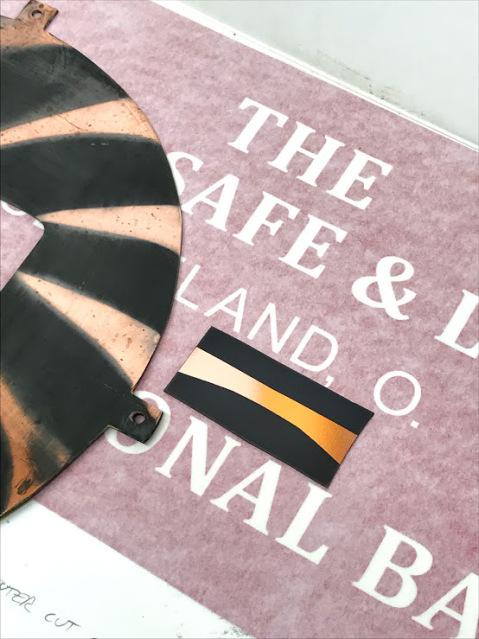
The nickel plated front cover was more difficult. Nickel is naturally more resistant to chemicals (especially when polished) so finding the correct chemicals to use is critical. It was hard to find information online and no one seemed to know what would work. Finally, I hit pay dirt when I called Jax Chemical Company in Mount Vernon, New York. There, a knowledgeable representative spent a good amount of time with me discussing what chemicals may give the results I needed. He also shared possible procedures that he knew other customers used for restorations.
It took a number of tries but I came up with a process that gives repeatable results. I also had to try several types of mask to create a design. This is the result I plan to use. It is just a hand cut pattern that is similar to the original to prove the process. I was pleased how well the edge of the mask held up and how sharp the edges of the lines are. In fact, they show every flaw of my hand cutting with an Exacto knife. With a computer cut mask it should duplicate the original design as close as possible.
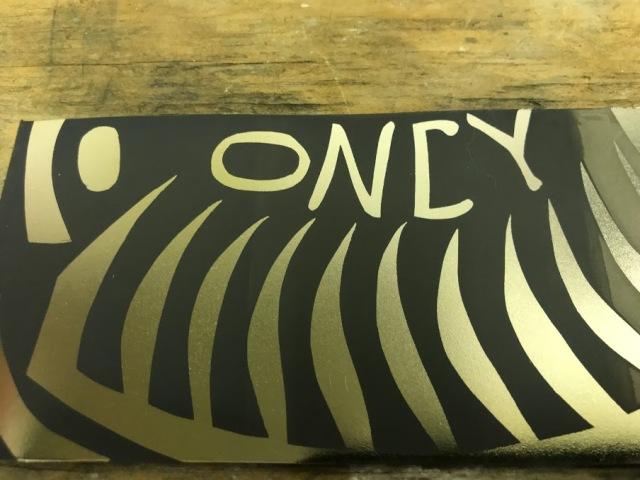
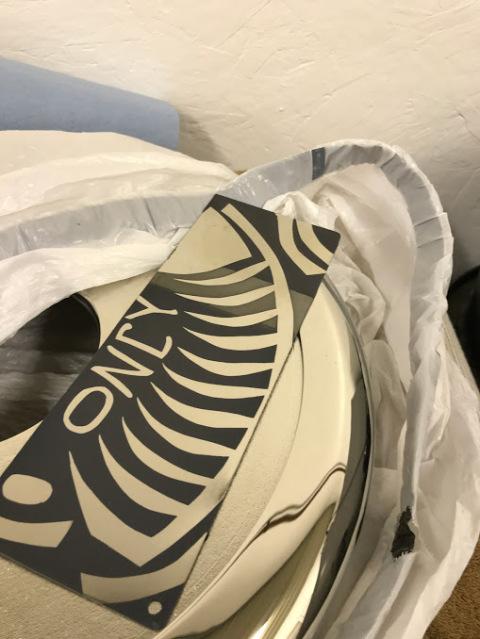
The original. I will go into more details once the pieces are done successfully.
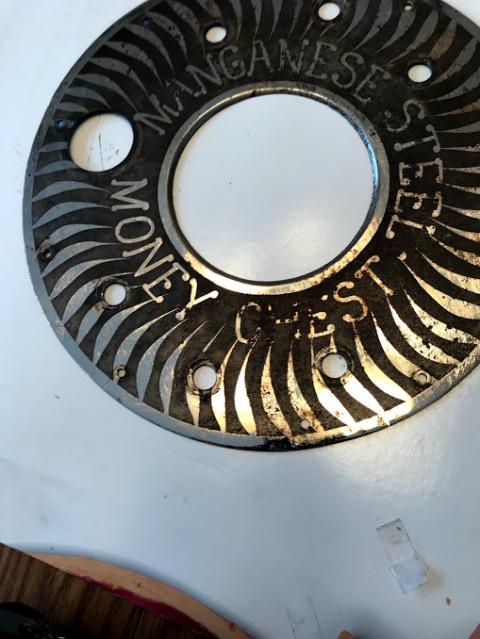
-
10-04-18, 03:45 AM #27

This National safe has been a drawn out project with waiting for third party suppliers to get their part done. The main holdup was the small sign shop that digitizes the artwork from my tracings. Once my stuff got moved to the abyss of the “someday” counter I knew I was in trouble. Despite extra time spent perfecting my beer consumption this winter, some progress has been made. (on the safe that is)
I was getting pissed off in January so I pulled the artwork for the front door cover (the most difficult piece) and searched for someone else to do it. I ran an ad on Craigslist and found an underemployed graphic artist who was eager to make some extra cash. I had the finished artwork back in less than a week. I then dropped off the digital file off at another sign shop that had the type of mask I needed to use to be cut. Two weeks later I finally had the finished mask.
Now I was confident the pattern on the original piece could be destroyed so off the cover went to be plated. At the plating shop they told me the spring car parts rush had started early and they were booking three plus months out, oh boy, here we go again. I was pleased to get a package in 6 weeks with parts but when I opened it I found that the cover was in copper instead of nickel. The cover was pitted and it took a lot of buffing to get the metal smooth. Knowing that this was an important piece on the safe and I was very anal about it, Steve wanted approval of the copper base before nickel plating it. It was good and I had it back in four days.
I guess I neglected to take a picture of it in the fresh nickel so we will move on to returning it to the original design. First the heavy vinyl mask is put on. It is cut with extra material to wrap around the edges. The back is sealed off with more vinyl to prevent an unwanted leak. Now comes the hard part. With the artwork and plating costs this is now a $430 part, and it now has to go into the blast cabinet to etch the pattern into the nickel. No margin for error now. The unprotected surface is blasted with fresh 120 grit aluminum oxide at a low 60 lbs of air pressure with the gun about 10” away. The blast has to be at 90° to prevent lifting the mask and yet you have to get the surface etched well at the edges of the mask. Here it is after blasting, the mask is white.
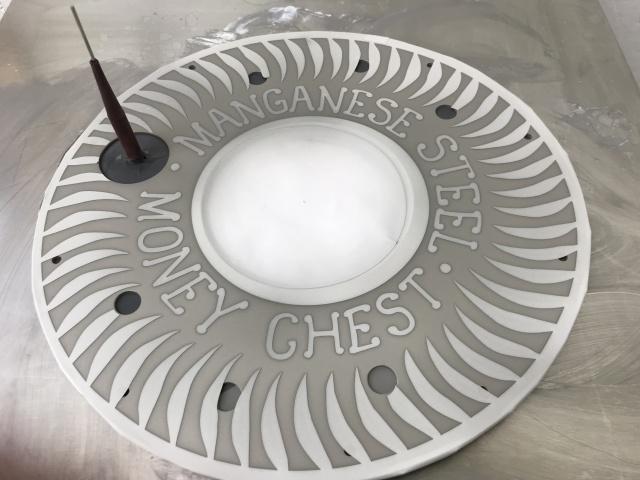
Once verifying the blast is even, the residual dust and grit is gently dusted off with a soft brush. Any scratch or defect may show up in the final finish. I robbed one of the wife’s Tupperware storage containers that was the perfect size for dipping the cover in a mixture of selenious acid, nitric acid, and copper sulfate. A tubeless tire plug/patch made the perfect handle for lifting it out of the acid.
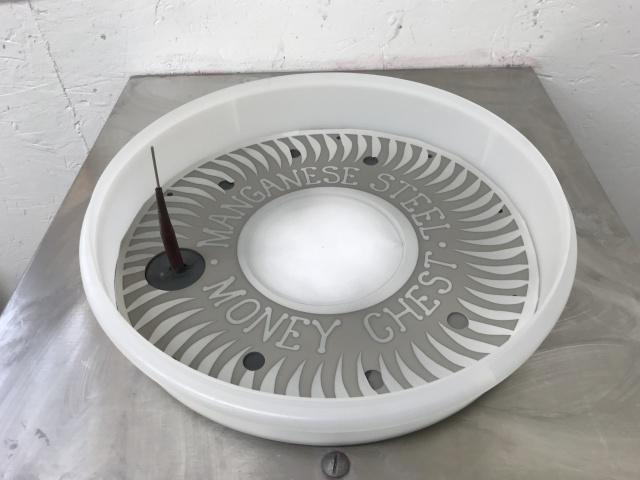
Once flooded with the acid it only takes about 45 seconds to darken the nickel. Once removed from the acid the part is rinsed with purified water, excess water blotted off, and dried with a heat gun to prevent any water spots in the finish.
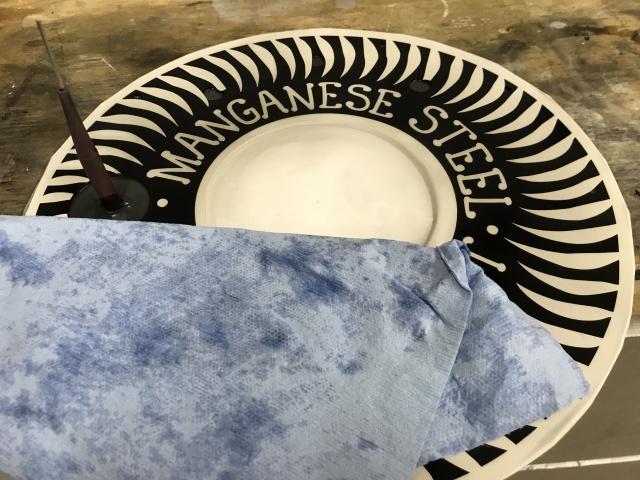
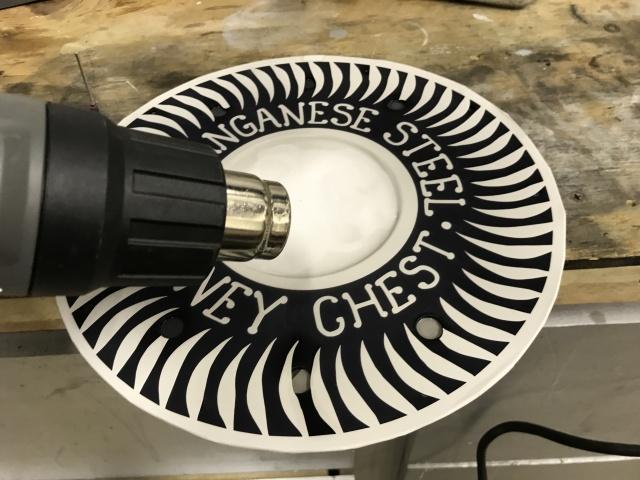
The final product. A nearly exact match to the original hand drawn design.
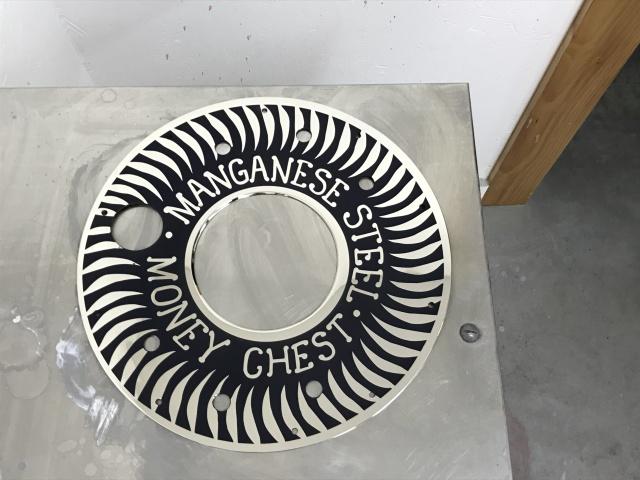
The inner door was copper plated and had a similar finish though it was well worn off.
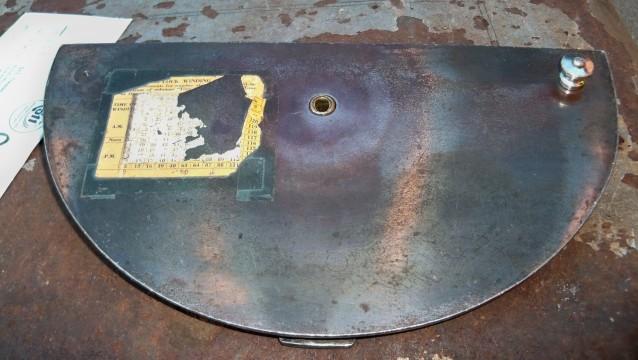
Often called a Japanned finish, the copper is treated with selenious acid. With a simple design to duplicate, I was able to hand cut the mask in vinyl. In tests the highly polished copper darkened well but when this part was dipped it took on an uneven finish. After the panic mode resided I gave the finish a light blast and then it took on an even finish.
The fresh copper finish.
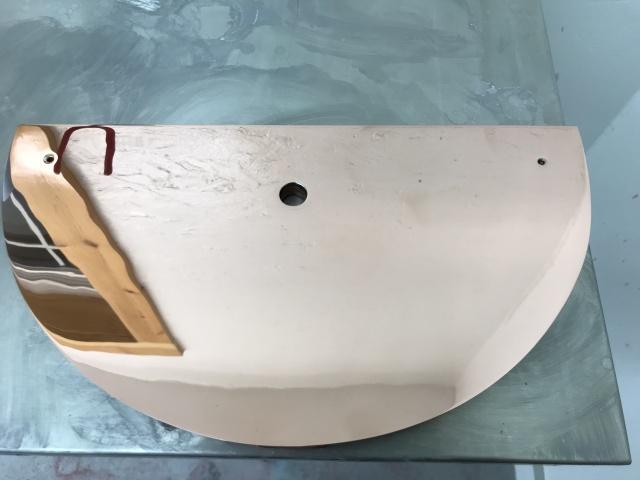
Mask applied.
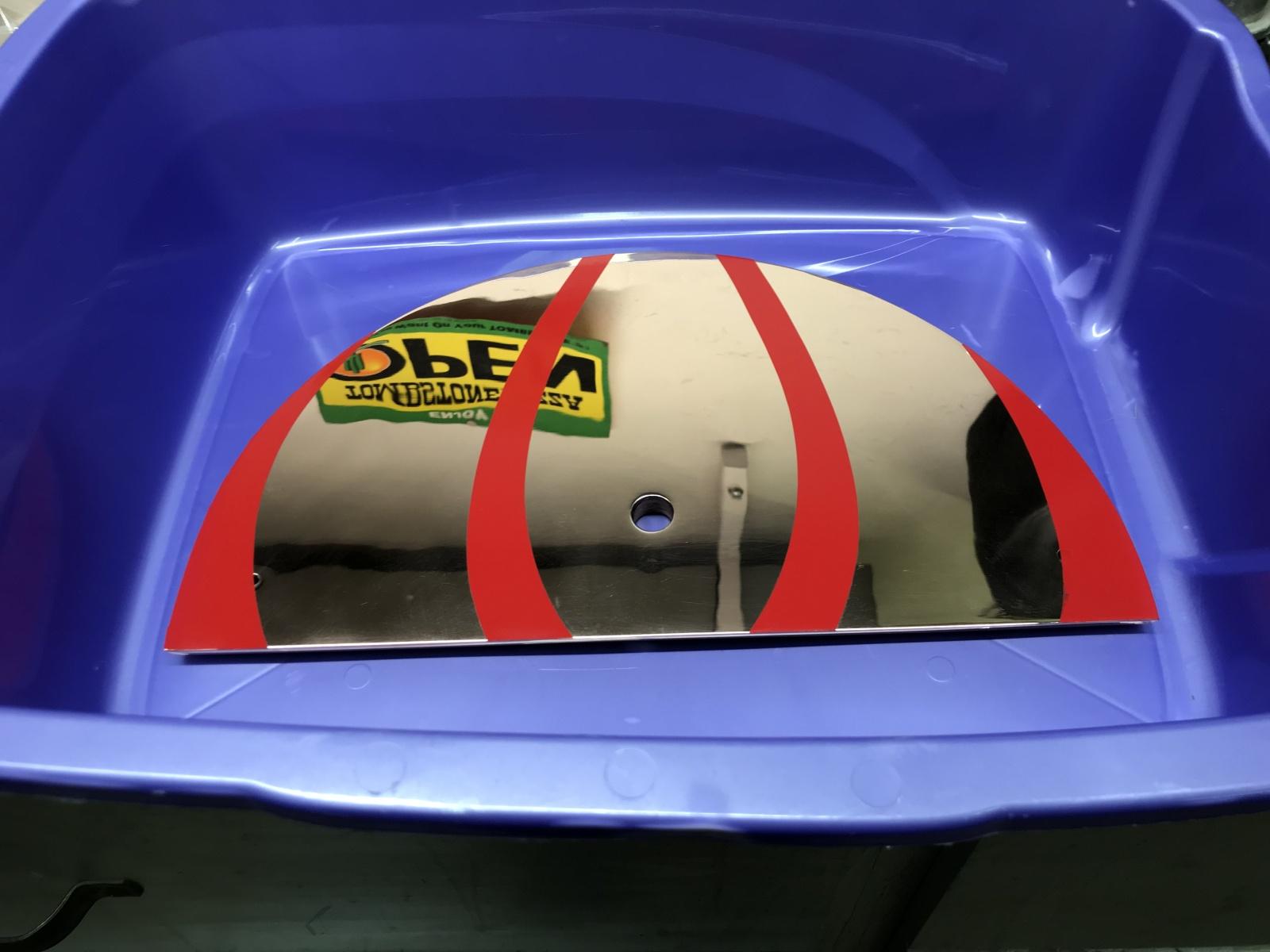
Finished. It is not symmetrical just like the original.
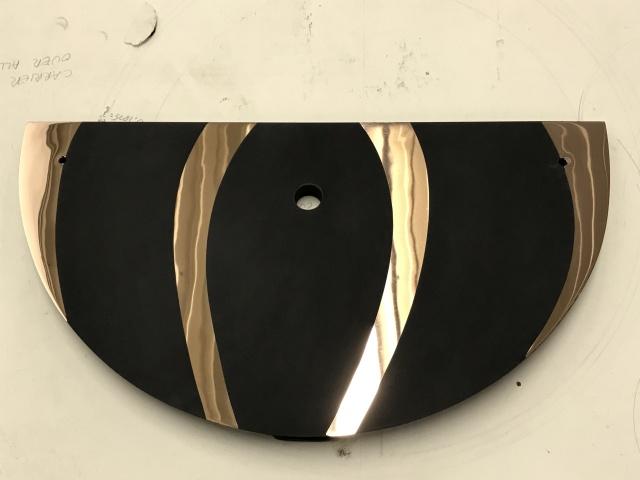
I did not have the door back cover plated yet as it fits very tight around the lock and time lock and new plating may cause it to not fit. This cover was in pretty good shape so I thought I might be able to salvage it with dipping it in acid to refresh the dark finish. I polished the bright swirls and then masked them off. I noticed that when I pulled the tape off from polishing some copper had lifted. When I gave the copper a very gentle blast at 20 psi it removed large areas of the copper from the steel. The copper was just flash plated and had poor adhesion.
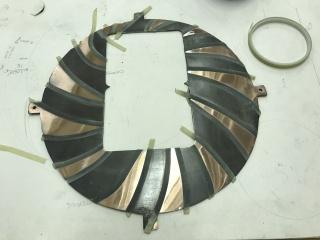
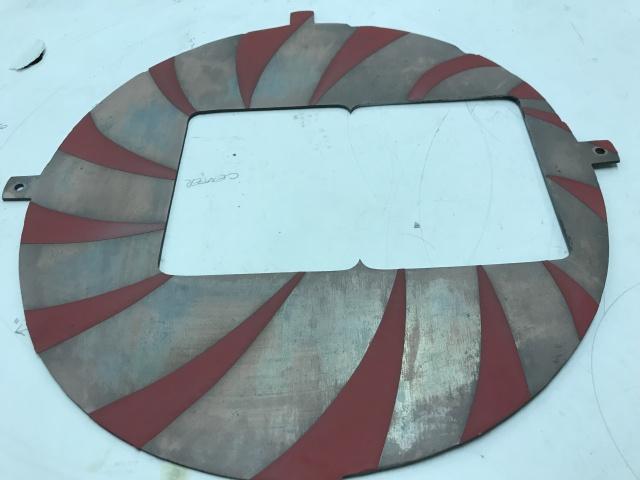
Oh well, win some – lose some. Once the door is fully assembled the cover will be fitted, relieved to allow for plating, plated, and then refinished. I doubt I would have been satisfied with the reworked original anyway.
-
17-04-18, 11:09 AM #28

The corrected artwork dribbled in over the winter. First to get done was the simple top, sides, and lettering. Often, I would just mask out the stripes with tape for the gold leaf. On this National there are two very thin (1/32") pinstripes inside of the gold leaf stripes. These would be tough to do by hand so I had a mask cut so I could do them all at once. Also, the gold stripes are not outlined on the sides and top of this National safe so clean straight edges are the order of the day. Measurements from the original were used to position the mask and it was taped in place. Then several pieces of masking tape are put across the center. The top half is folded down and the backing is peeled back and trimmed off. The top is put back in place and squeegeed out.
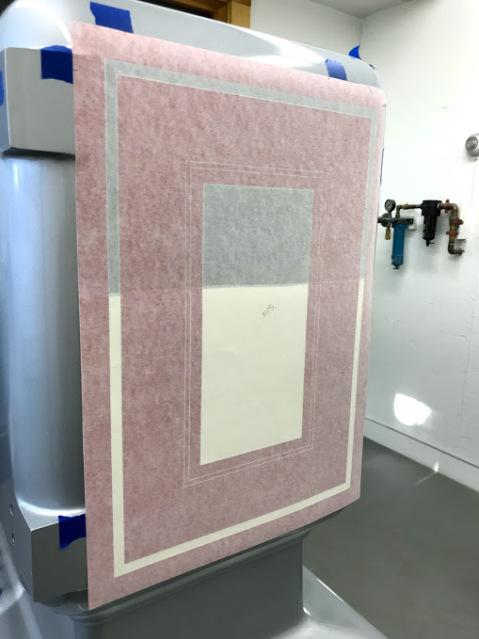
Then the tape is removed and the backing is removed from the bottom half and it is squeegeed out.
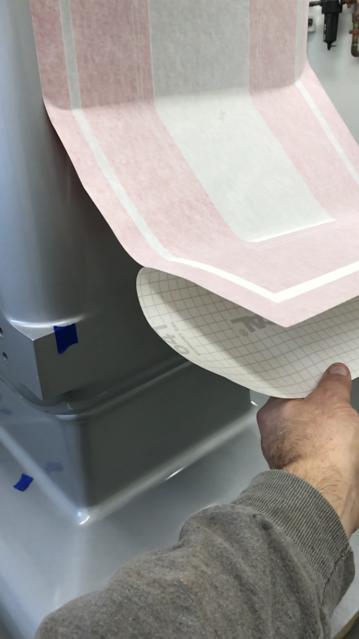
Now the white carrier mask is removed leaving the mask in place. There are a number of mask materials available, in this case an economy vinyl is used as it is very thin and the adhesive doesn't set up quickly. Being thin helps prevent a ridge of adhesive for the gold leaf developing at the edge and the weaker adhesive on the vinyl promotes easy removal if not left in place for too long. Here it is ready for the gold leaf.
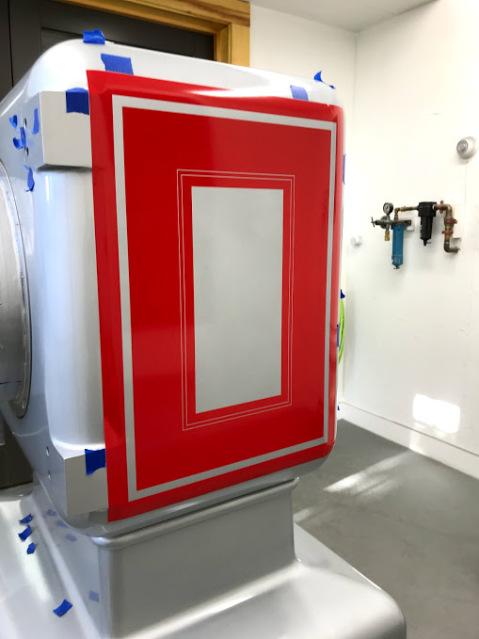
Once the size (varnish based adhesive) is brushed on and allowed to dry to the proper tack, the gold is applied and brushed into place. Once brushed in and all the waste loose gold is cleaned up the pinstripes are painted with 1shot black sign paint with a pinstripe brush. At this point it won't win any beauty awards. You can see the gold has also been put on the mask for the lettering on the base of the safe.
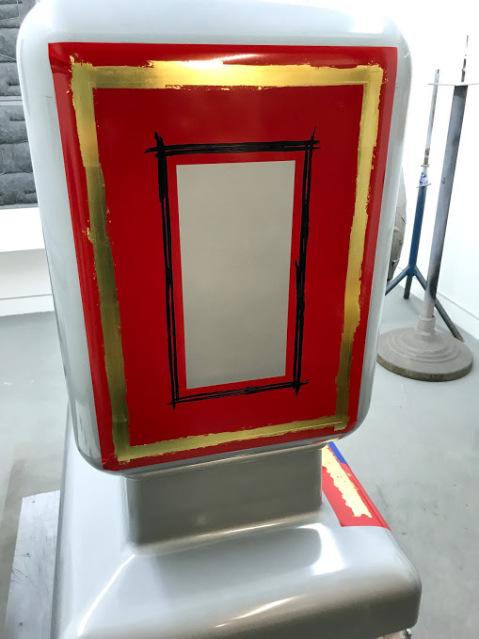
After some dwell time the mask is carefully removed to leave the stripes and lettering with nice sharp edge lines. Certainly updated from the original.
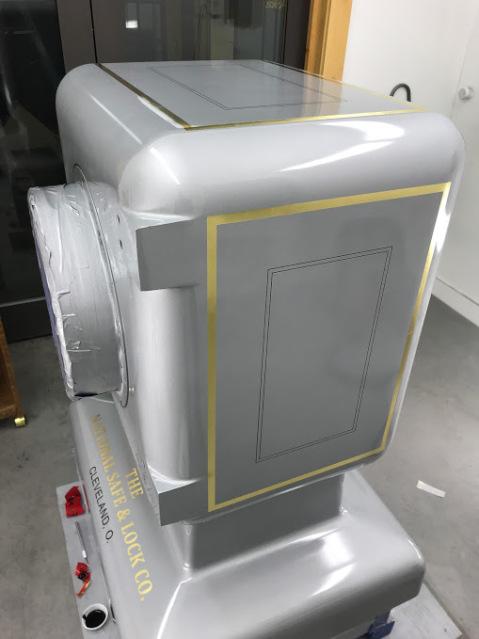
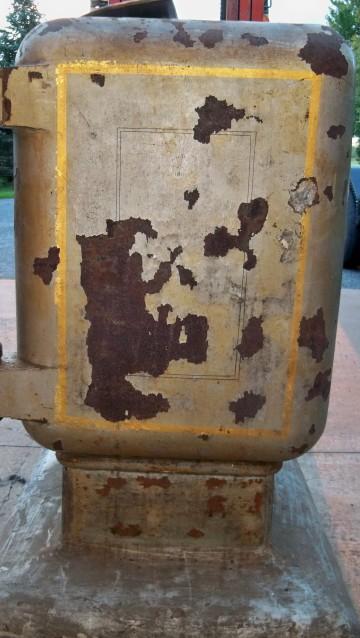
Under certain lighting the 23 karat gold really pops!
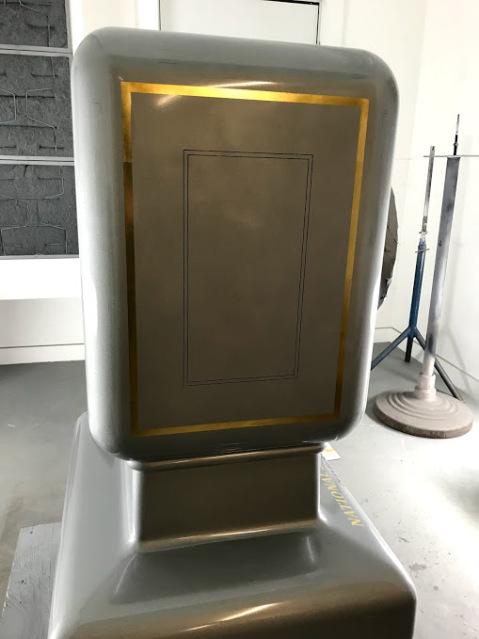
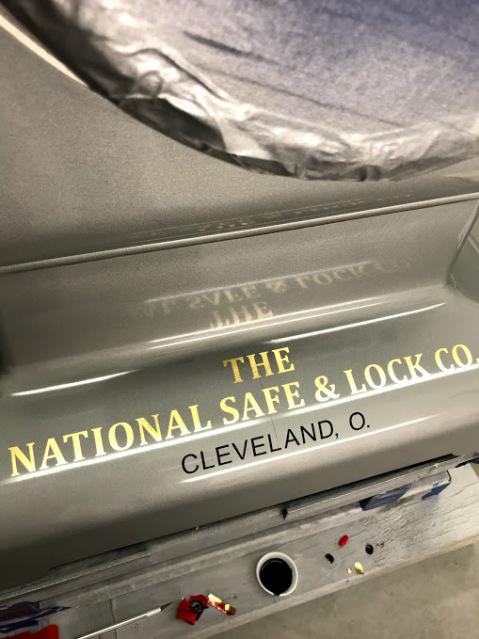
As March rolled around I was getting really pissed off and started hounding the gal at the sign shop to get the artwork done. I sent her numerous texts every week just to be a pain. Finally she said that she had the front of the safe done but was having problems getting the hinge to match my tracing. I went into the shop to assist and found she had used only the center design of the scan of the tracing and was trying to build the top and bottom manually on the computer. She assumed the hinge was circular like the door opening when it is oblong and it was throwing the whole thing off. I rescanned the tracing of the top of the hinge on her scanner and had her attach it to the corrected center and with a few adjustments it was good to go. This was all done in Adobe Illustrator. Then she copied the top to the bottom and with a few more adjustments and measurement confirmations it was done. Just over an hour. I waited 5 months for this?
I was happy to get the last of the artwork home and cranked up the heat and got started. Here is the hinge mask applied.
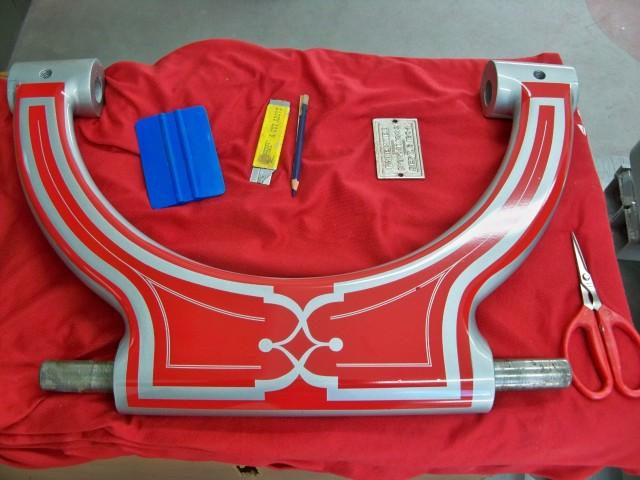
Here the front mask is positioned ready to be applied. The stripes wrap around the curves in the corners which took some finesse to get it to work out.
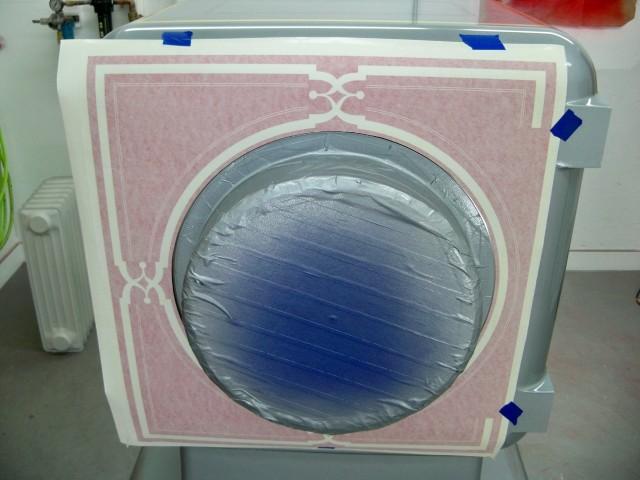
Once the front of the safe was gold leafed, I could position the name of the bank centered between the front and top stripes. I had this mask for several months but could not use it until the front was done.
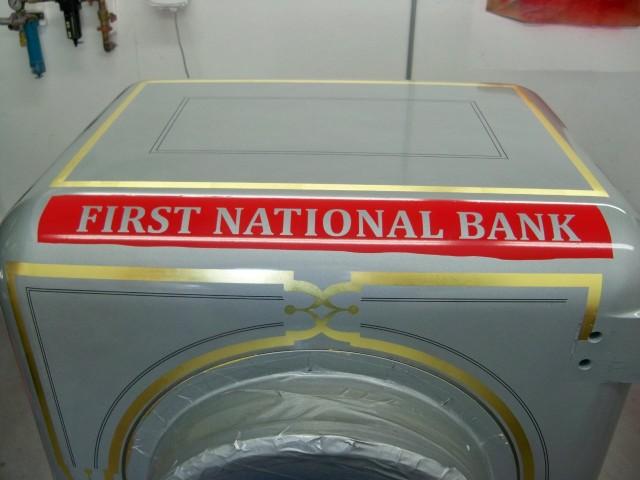
It is always fun to apply the gold leaf. Initially when applied it looks like one will have a disaster in the making.
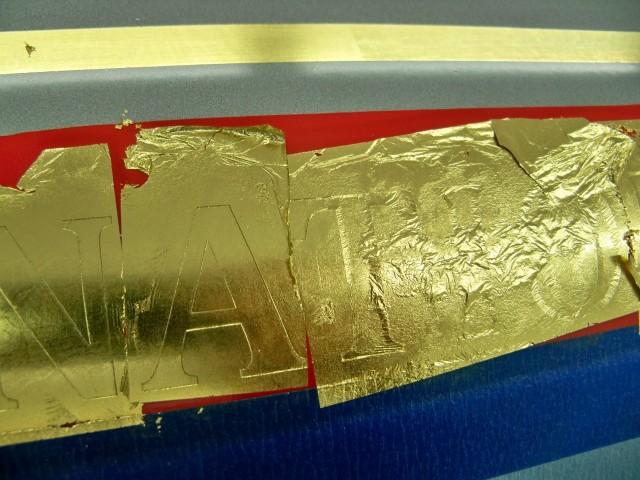
Now the gold is done. While it looks nice it is still not finished.
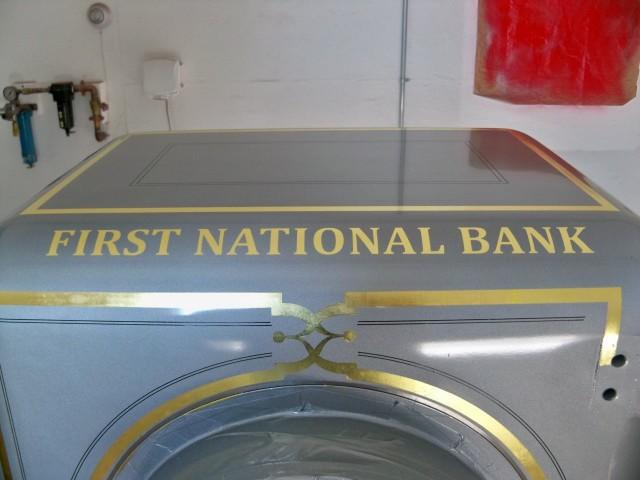
Now it is time for the lettering to be outlined in black and the stripes in red. A few other stripes and finishing touches and the artwork is done.
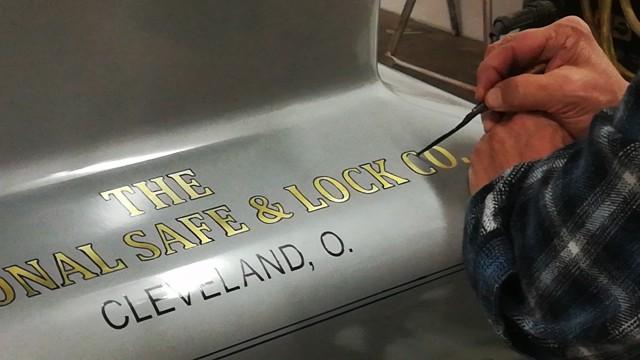
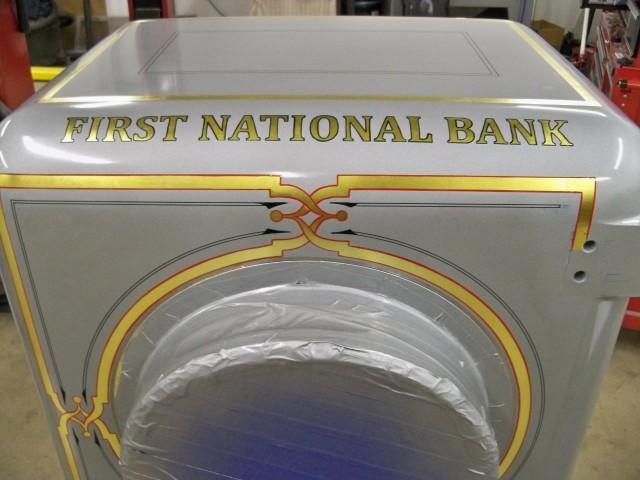
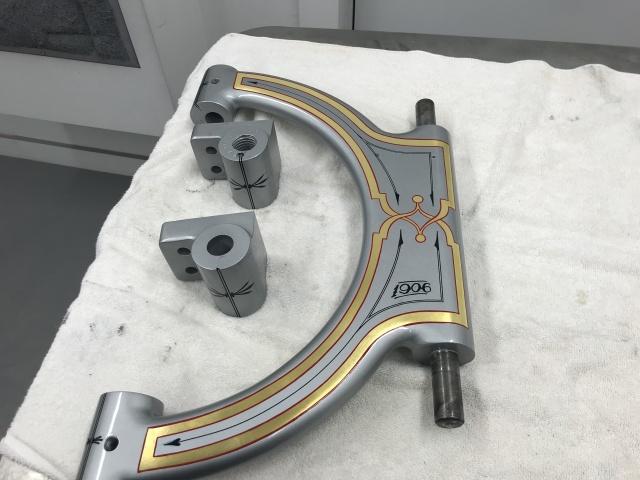
-
17-04-18, 11:43 AM #29

It is always fun to put together newly painted and plated parts but it is also tedious as you don’t want to scratch anything. Working slow, thinking before doing anything and using lots of masking tape to protect fragile surfaces becomes standard procedure.
First the hinge was put back on the body. I was nervous about this step but the bolts fit in the hinge pockets very tightly so they had to go back to the same position that they were in originally. The hinge is not adjustable.
First the hinge parts are prepared and the lower bearing assembled. There is that extra spacer that was made on the lathe.
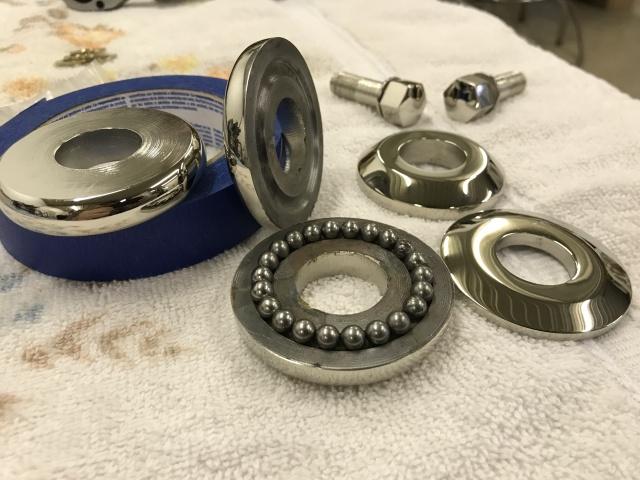
The hinge is fit.
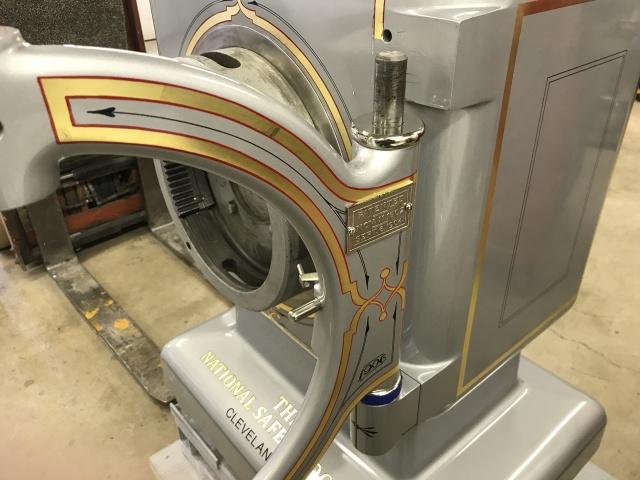
All bolts and shiny parts get taped to protect the new nickel plating. Plated washers were added to prevent the bolt heads from scoring the paint.
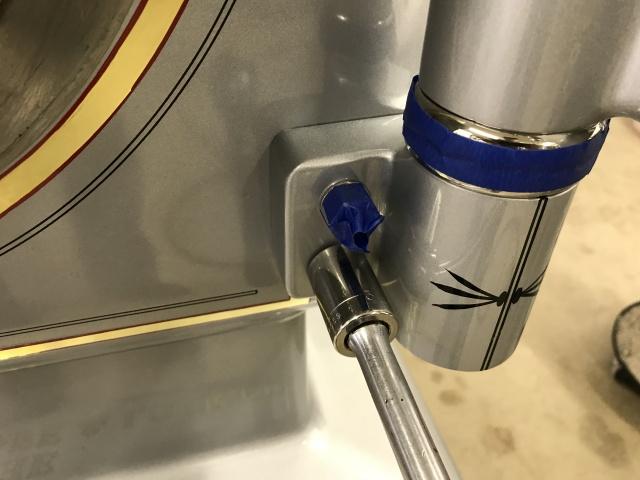
Next came mounting the hinge to the door that has been in the body for many months. The door is supported on two carriages (four wheels on each one) that the door pivot bolts pass through. The carriage wheels track in grooves in the door. The door cover bolts to the carriages to lock it all together as one unit. It took a number of installs to get things right. The door pivot bolts not only adjust vertically by turning the large polished finials, they are also adjusted in/out and left/right by four adjuster bolts on the top and bottom of the door end of the hinge. It’s a very complicated adjusting procedure. I struggled to get the door to fit well but after many tries all of a sudden I hit the magic combination and the door fit the opening perfectly. Once all bolt adjustments are noted, it comes apart one more time to grease and oil all surfaces.
The door carriages, the dial cup and ring are also installed in this picture.
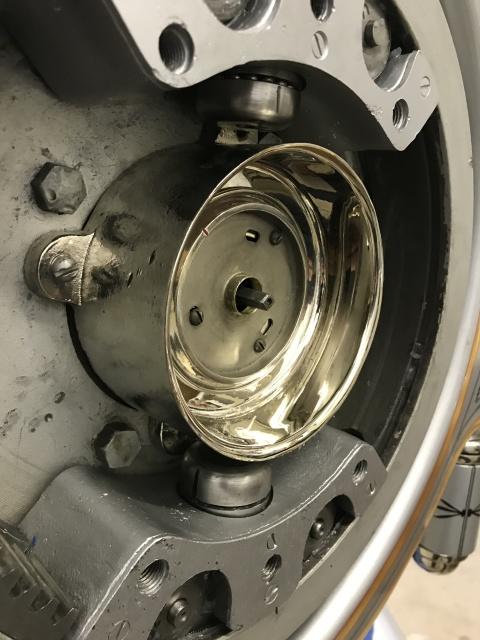
Trial door fitting.
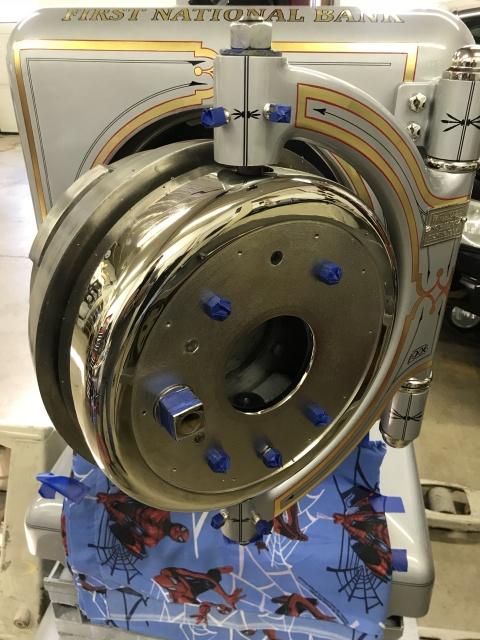
Once the door fits the hole the next challenge is adjusting the door lug ring and inner lug ring that control the position of the door rotating as well as the wedging of the door in the taper of the opening. Ideally, the door wedges tight just as the rotation hits the stop where the locking bolts can be thrown out into the slots in the inner ring. This will make the door seam impenetrable to nitroglycerine attacks. I set the door tolerances loose so as to reduce strain on the door drive system. No reason to protect against nitro in this over regulated day and age. When I disassembled the lug ring it was shimmed about .035 with cut up 1906 time cards from the National factory. I shimmed with .046 (uncompressed) gasket material which gave the perfect clearance. The door closes and rotates so nicely I don’t think KY jelly could assist. This whole door fitting process took the better part of two days.
Gaskets on the lug ring.
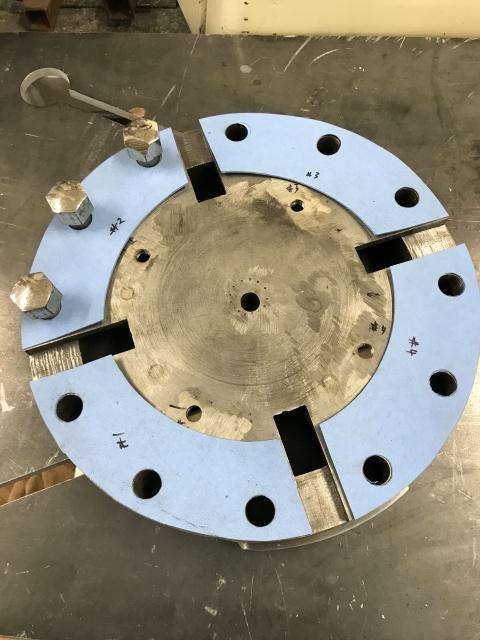
The inner lug ring, inner compartment spacer, and shelf must be fitted as a unit. There is no joy in working with these heavy parts inside a safe!
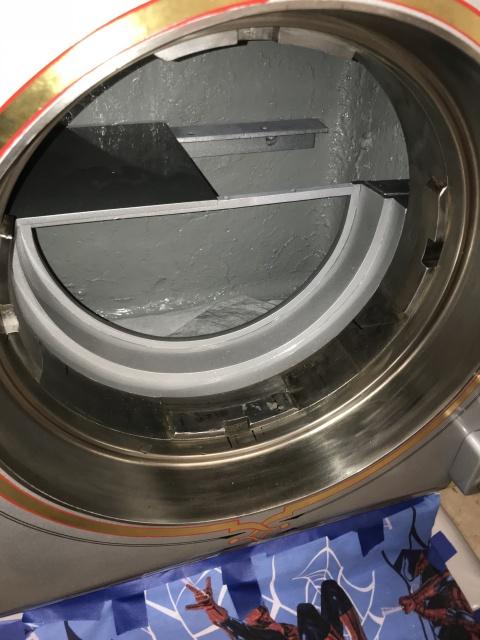
Once the internal fitting is done the shelf is completed, the original carpets are installed and the compartment door.
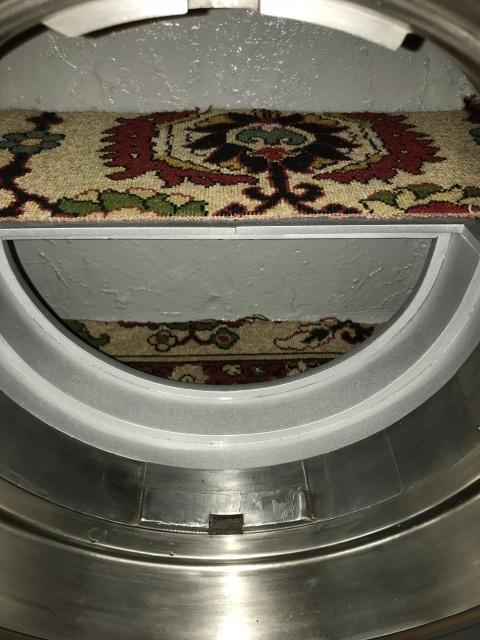
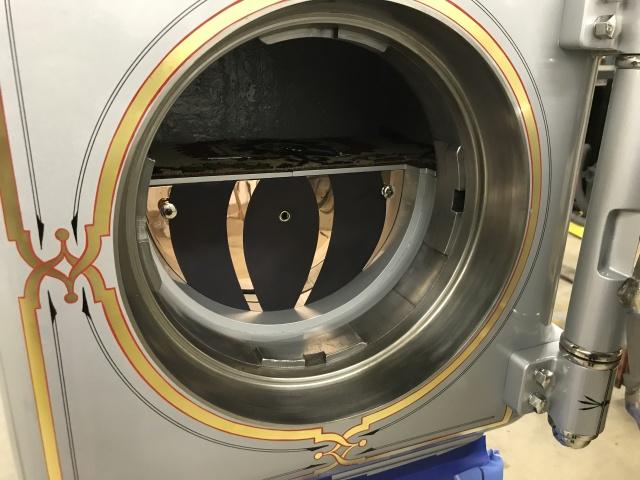
After the door was fitted, final assembly of the lock, time lock, and associated door linkage was next on the list. The lock is a Yale 65 ½ fiction fence model. It differs from most fiction fence locks in that it has a full back cover vs. a wheel pack hole and the friction fence is not a sealed assembly. Instead it is separate pieces and has a brass washer under the pivot bolt head to retain the springs. This lock has a lot of wear in it from a lot of use and the fact that the lock directly moves all the door internal linkage and inner door locking bolts. The internal flat springs were missing inside the friction fence so an external wound spring was added to replace them which added extra drag and wear on the wheel pack drive wheel.
Inside the 65 ½ Yale lock.
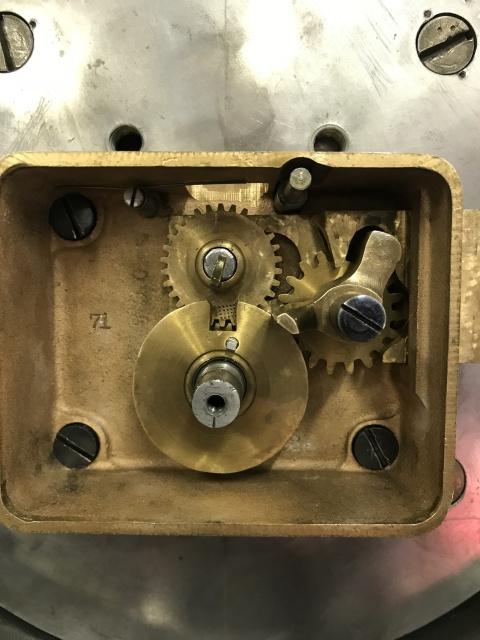
I wondered how I could repair the friction fence and what I could use for springs. While measuring clearance on the door lug ring the feeler gauge in my hand provided the answer. The high carbon feeler gauge shims are similar to spring steel. After measuring inner and outer diameters and the grooves in the fence I calculated .006 would be the correct thickness. I cut two strips and assembled the fence only to find it rotated a bit stiff. Dropping to .004 gave about the right feel but one of the strips could slip out of the groove on one end where the hole of the fence was worn. I switched to a .006 strip on that side after ever so slightly filing the groove. Now the fence had good rotational friction and the springs stayed in place. I hope Doug approves of this repair.
Grooves inside the fence.
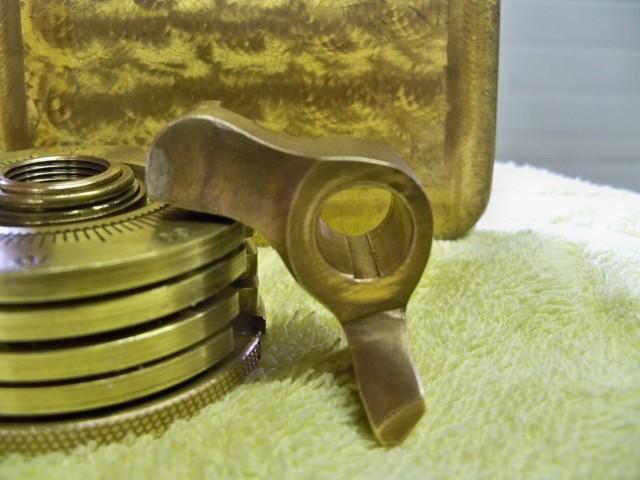
Fitting new strips.
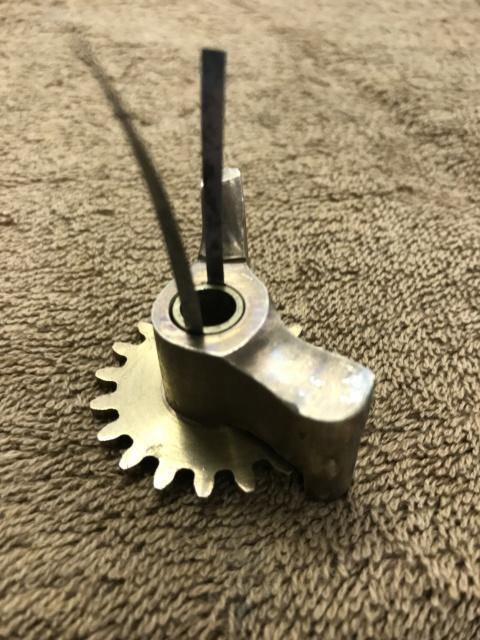
Wear inside the lock also allowed the lock bolt to side out to far if the dial was turned forcefully to extend the bolt to lock the safe. If that happened, the friction fence would jam against the outer edge of the drive wheel gate preventing it to pull into the wheel pack gates. This would cause a lockout. To prevent the bolt from extending to far it was jigged into the mill and a hole was drilled into the end of the lock bolt. After threading the hole a socket cap screw was machined to the proper clearance to contact the outer ring of the door.
Drilling the lock bolt.
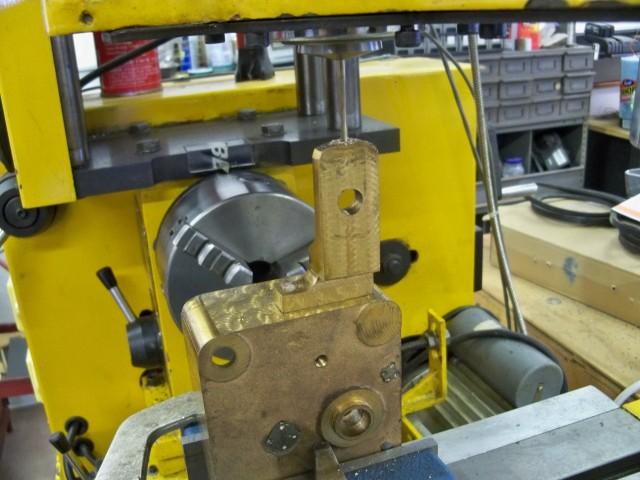
New lock bolt stopper in place.
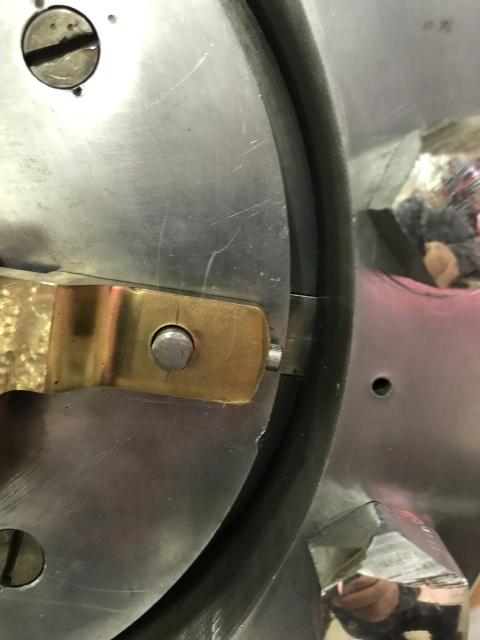
Here is a video of dialing action inside the lock so you can see how a friction fence works. Also shown is the simple pivoting lock operated by the time lock to prevent the retracting of the lock bolt. And finally, all the inner door linkage that must be moved by the dial to activate the internal door bolts. My sloppy dialing is accompanied by ZZ Top.
The door is now complete other than the rear door cover. It has been fitted and sent out for new copper plating. The twelve ¾ inch bolts that hold the lug ring to the door still need to be replated but I have to repair some damage to five of them. Other than that, the National Manganese Steel Money Chest is finished. Drum roll please.
In all her glory…
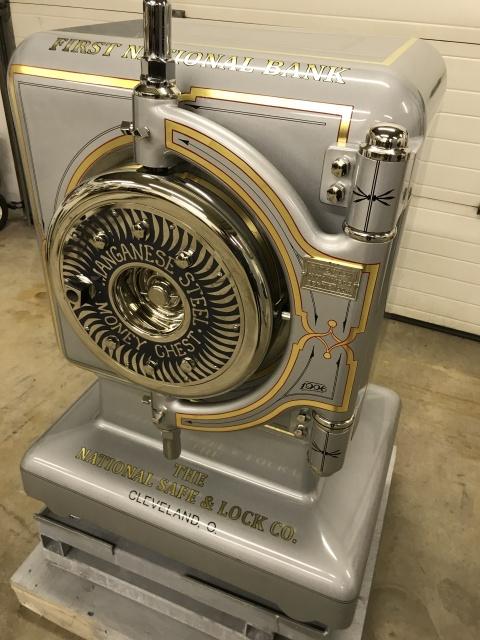
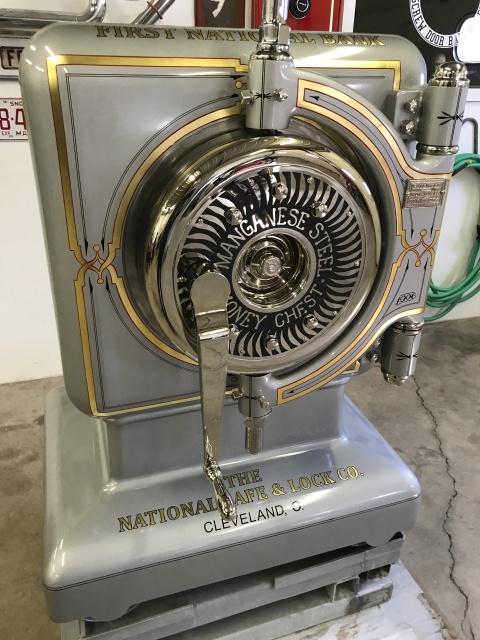
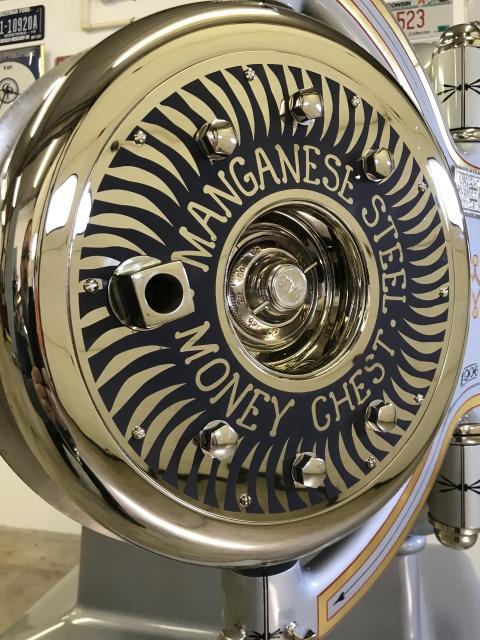
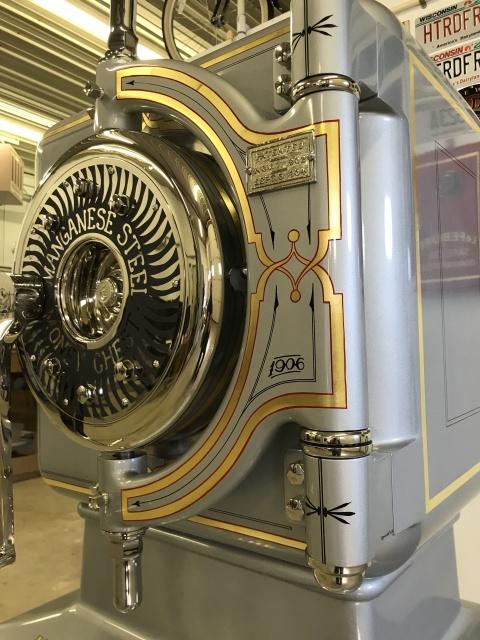
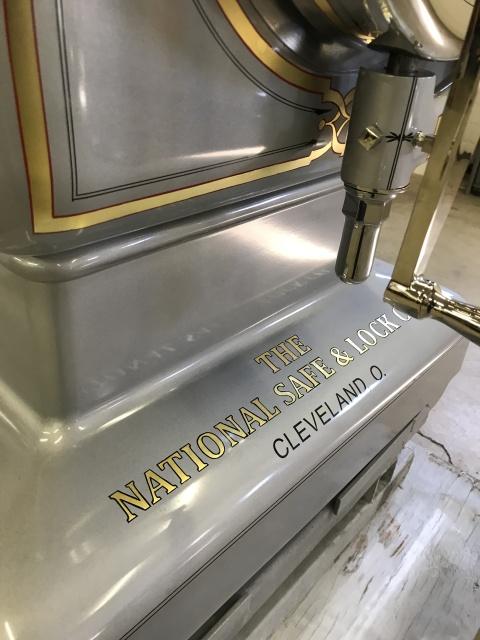
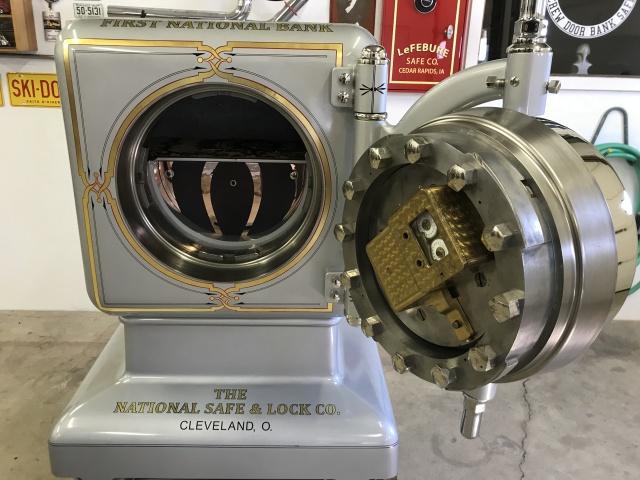
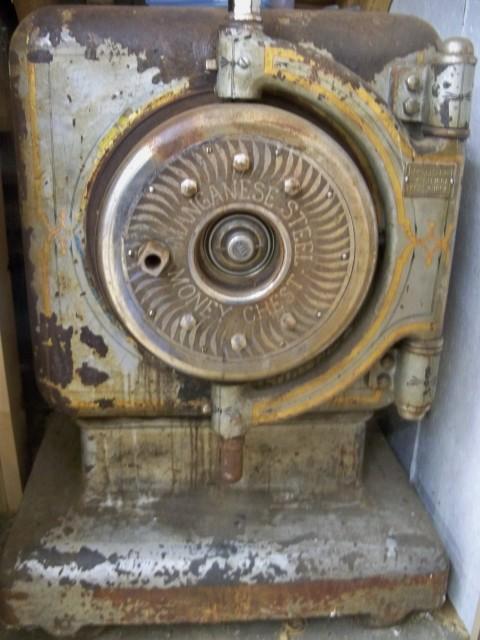
-
17-04-18, 12:24 PM #30

Spectacular work! And thanks for all the pictures and work through descriptions.
Thread Information
Users Browsing this Thread
There are currently 1 users browsing this thread. (0 members and 1 guests)




 Reply With Quote
Reply With Quote




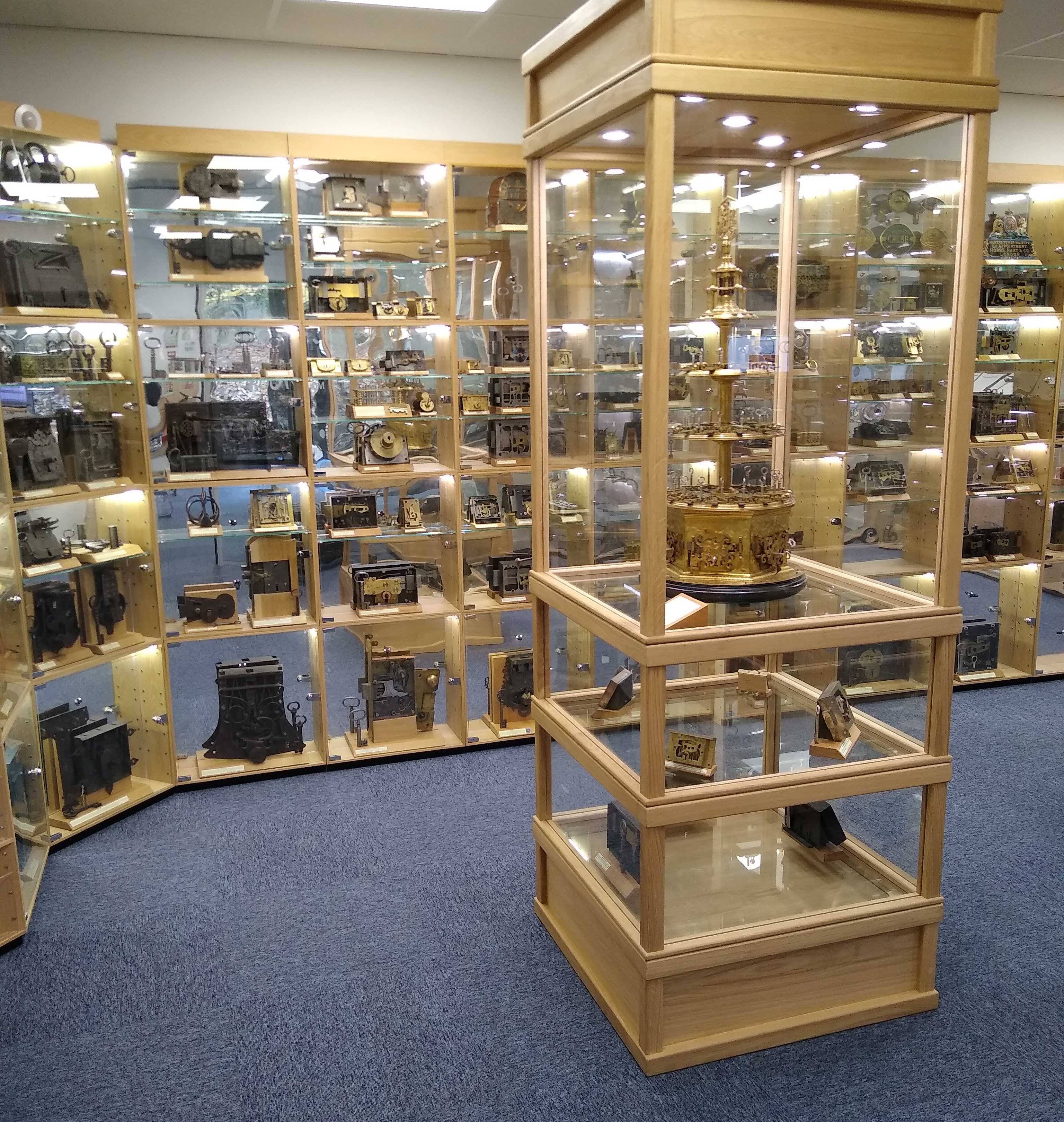






Another point Gary is that although the key is marked 'patent' nothing has been found in the British patent abridgements, so maybe its one that was 'applied for' but not granted... The mystery...
Show & Tell Meeting in the...